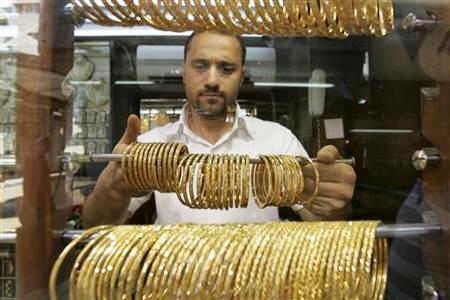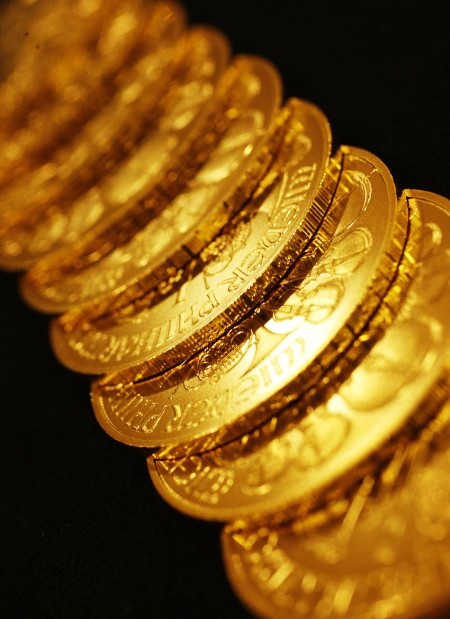Photographs: Jayanta Dey/Files/Reuters Devangshu Datta in New Delhi
Last week, Manappuram Finance saw a sharp fall in share price, along with downgrades, disinvestments by institutions and negative advisories.
The reason is simple: The company will register losses of about Rs 50 crore (Rs 500 million) in Q4, 2012-13.
Manappuram lends money against gold.
It has to absorb Rs 250 crore (Rs 2.5 billion) in defaults.
The price of the gold it holds as collateral has fallen.
So, it cannot recover the entire amount.
. . .
Why investors' perception towards gold should change
Photographs: Reuters
The other listed gold-loan major, Muthoot Finance, saw a big drop in share price, for fear of similar problems.
The price of gold, in dollar terms, has fallen 12-15 per cent in six months.
This is the longest period of continuous decline in 16 years.
It could have interesting repercussions, not just on gold-loan non-banking finance companies but on the broader space of personal finance, as well as India's macroeconomic status.
Gold has been in a bull run since 2002, when international prices started climbing from $300/ounce (about $11/gm).
. . .
Why investors' perception towards gold should change
Image: An employee displays gold necklaces at the 'Gem and Jewellery India International Exhibition 2010' (GJIIE) in Chennai.Photographs: Babu/Files/reuters
The price was $700/ounce ($25/gm) in 2008, when the subprime crisis broke.
The bull run that followed took prices up till all-time highs of $1,900/ounce in 2012.
The metal has been a terrific hedge against currency weakness and fears of stagflation, with a compound annual growth rate of about 19 per cent.
It was the best asset to hold between 2008 and 2012.
It has now reacted till about $1,600. If the global economy does recover through 2013 and major currencies stabilise, prices could fall further.
. . .
Why investors' perception towards gold should change
Photographs: Reuters
Gold is a counter-cyclical.
It loses value when the business cycle is up, since it has limited industrial utility and earns no interest.
NBFCs like Manappuram and Muthoot operate large pawn-broking operations, lending against gold pledged as collateral.
The Reserve Bank of India has a prudential loan limit of 60 per cent of the value of the pledged gold.
NBFCs charge 28-30 per cent interest on these loans.
If the borrower defaults, the metal must be sold to recover the principal.
. . .
Why investors' perception towards gold should change
Image: A woman holds gold bangles at a jewellery shop in Kolkata.Photographs: Jayanta Shaw/Files/Reuters
Gold-loan NBFCs are not allowed to raise loans through corporate deposits.
Some issue non-convertible debentures.
They also use their gold reserves to raise more cash, securitising the metal to raise money from banks.
The spreads -- the difference between their borrowing costs and the on-lending rates they can charge -- are large.
This makes the gold-loan business very profitable if gold prices rise and defaults are few. But managing asset-liability mismatches get tricky, if gold prices fall or defaults rise or both.
. . .
Why investors' perception towards gold should change
Image: A salesman arranges gold necklaces at a jewellery shop in Agartala.Photographs: Jayanta Dey/Files/Reuters
If prices drop, the NBFC must offer more gold to creditors. If borrowers default, it must sell the gold it holds at whatever price it can get.
This means gold-loan NBFCs are themselves counter-cyclical businesses.
If the economy is buzzing and gold prices fall, these businesses struggle to stay profitable.
Their fast growth in the past five years was precisely because the economy was in trouble and gold prices were rising.
. . .
Why investors' perception towards gold should change
Image: A Jordanian goldsmith holds gold bracelets at his shop in Amman.Photographs: Muhammad Hamed/Reuters
Making a call on gold price trends through 2013 is a toss-up.
Prices might climb again.
The Cyprus crisis could push the Euro zone into further trouble.
Growth is slow in the US and China. Japan could fail to kick-start its economy.
But if growth does pick up in the US and China, and Japan succeeds or the European Union overcomes its problems, gold prices could fall a long way.
Even if only some of these positive global outcomes occur, gold prices could fall.
If prices fall, it will probably reduce the current account deficit, since India is the world's largest importer.
. . .
Why investors' perception towards gold should change
Photographs: Reuters
But it will have an inverse wealth effect on household savings and put jewellers under pressure as the value of their inventories is reduced.
Through the last few years, investors and households alike have seen gold holdings escalate in value.
However if that trend reverses, it might be time to consider heresy and maybe even sell some of the family jewellery to reduce exposure.
Sentiment apart, gold is just another asset, with its own advantages and liabilities. Through most of the 1990s, the yellow metal traded below $400.
A reversion to those levels would have a catastrophic effect on household wealth.




article